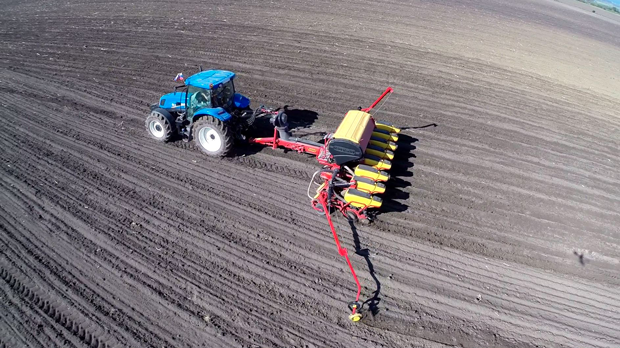Until 1980s, majority of European countries used the same methods to cultivate agricultural land.
Harvests were followed by deep ploughing and the soil was prepared for autumn and spring sowing. Machines only rarely went on the sowed areas during vegetation seasons, thanks to which rainwater was able to soak into the uncompressed soil.
In the last 30 years, however, compressing of agricultural soil grew severalfold thanks to the new technologies and efforts to minimise agricultural costs.
Compressing cycle




In springs and autumns, the soil is prepared for 10 – 18 cm deep sowing. Thus, crops are sown only in a thin upper layer with a thick layer of compressed soil underneath it.
The first time when tractors compress the soil is during the actual sowing. Later, they return to the fields to spray the crops and fertilise them and the already compressed layer gets compressed even more.
The rainwater which falls on such field soaks the top – cultivated – layer of soil, yet the compressed layer underneath retains only a minimum amount of water. The remaining water runs off to lower areas, taking along fertile soil, too.




After crops sprout, machines are back to the fields both in springs and in autumns. We start with fertilizing and the compressing cycle goes on...
When it rains, the situation happening after sowing occurs again, yet this time water runs off from a much larger area. The water which does not soak into the ground in hilly landscape immediately runs off to the nearest canal or brook. In the lowlands, the water runs off quickly along the furrows into canals and via rivers into the oceans. Few hours after the rain, canals and brooks are empty again.
Even though some of the water forms lakes in the lowest parts of the fields and it can look like the soil is soaked through, the truth is that the underlying compressed layer of soil does not let the water through.
As soon as the crops are 30 cm high, the entire fertilising and compressing process takes place once more.
Muddy water keeps on flowing off of the fields washing up arable land. On the fields with greater inclination it happens frequently that clear water that is running off as the arable land located on the Earth’s surface after the agricultural activities has already been washed off into the dams and oceans. Fields become rocky and, consequently, less fertile.
The process of spraying and sprinkling and of massive compressing of soil continues as long as the crops are growing. And then comes the harvest. As a result of all this, some fields are no longer able to absorb water areally after autumn harvests.
Fields like these were one of the major causes of 2014 floods in the United Kingdom.
Causes of floods in Egland in 2014
Measurements on agricultural land


We have carried out a set of water seepage measurements on agricultural land after the crops have been harvested.
First, we have simulated the 100 mm rainfall on a 10m2 large plot of arable land which had been ploughed 30 cm deep, adjusting the speed of the rainfall so that the water gradually soaked into the pores above the ploughed part instead of running off of the plot. The simulated rain lasted for 2 hours and 35 minutes.
We have dug six 60, 50, 40, 30, 20 and 10 cm deep holes on several fields and especially in tractor tracks, and one additional 10 cm deep hole at a plot of uncompressed soil.
We have simulated the 300 mm rainfall in each of these holes, making sure that the level of water in the holes did not exceed 10 cm from the bottom of the holes at any given moment.
Water in the 60, 50 and 40 cm deep holes soaked fastest.
Water in the 30 cm deep hole and in the 10 cm hole at the uncompressed soil took roughly the same time to soak. However, the 20 cm hole was able to retain only 17 mm of water in 3 hours. (zdôrazniť pri čítaní)
Moreover, the compressed 10 cm hole retained only as little as 5 mm of water in 3 hours.
Hence, it can be claimed that a compressed soil layer prevents rainwater from soaking into the ground.
We have also carried out comparative measurements on heavy and mid-heavy soils. Even though these soils took longer to drain the water, they have absorbed it in the end. They have absorbed 5 to 20 mm of water in one day, which exceeds average daily precipitation levels in the given location severalfold.

